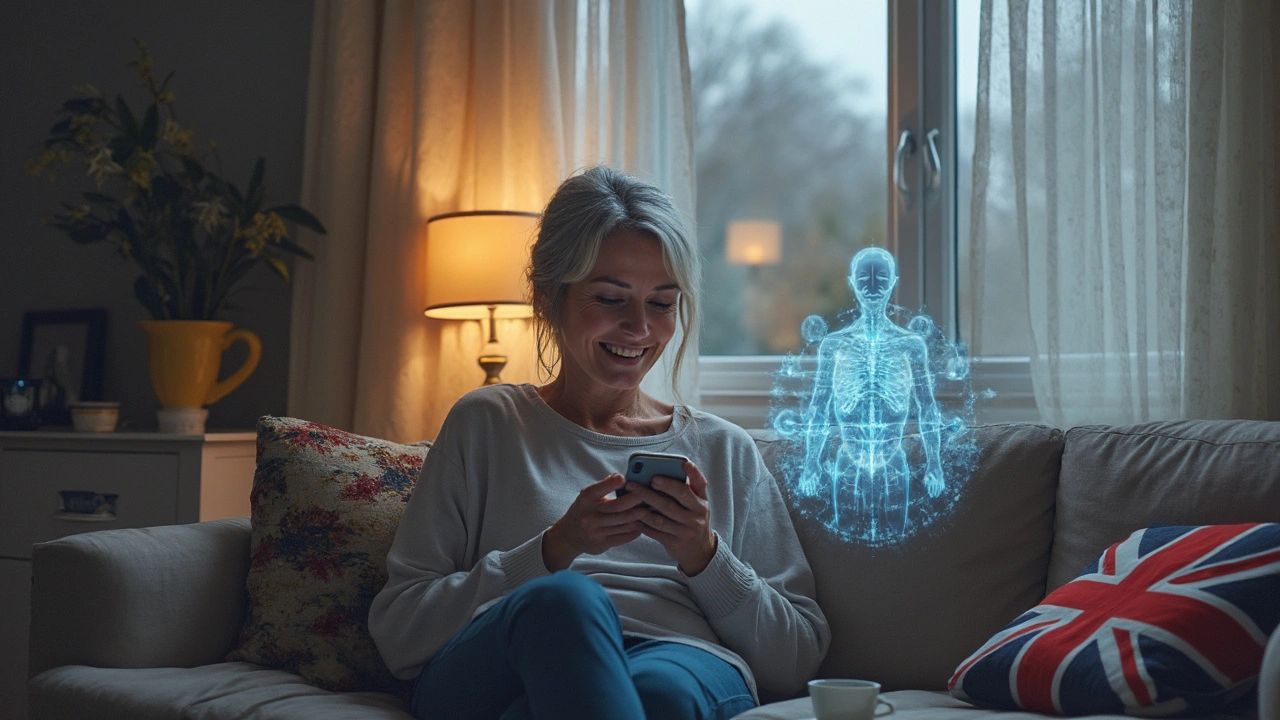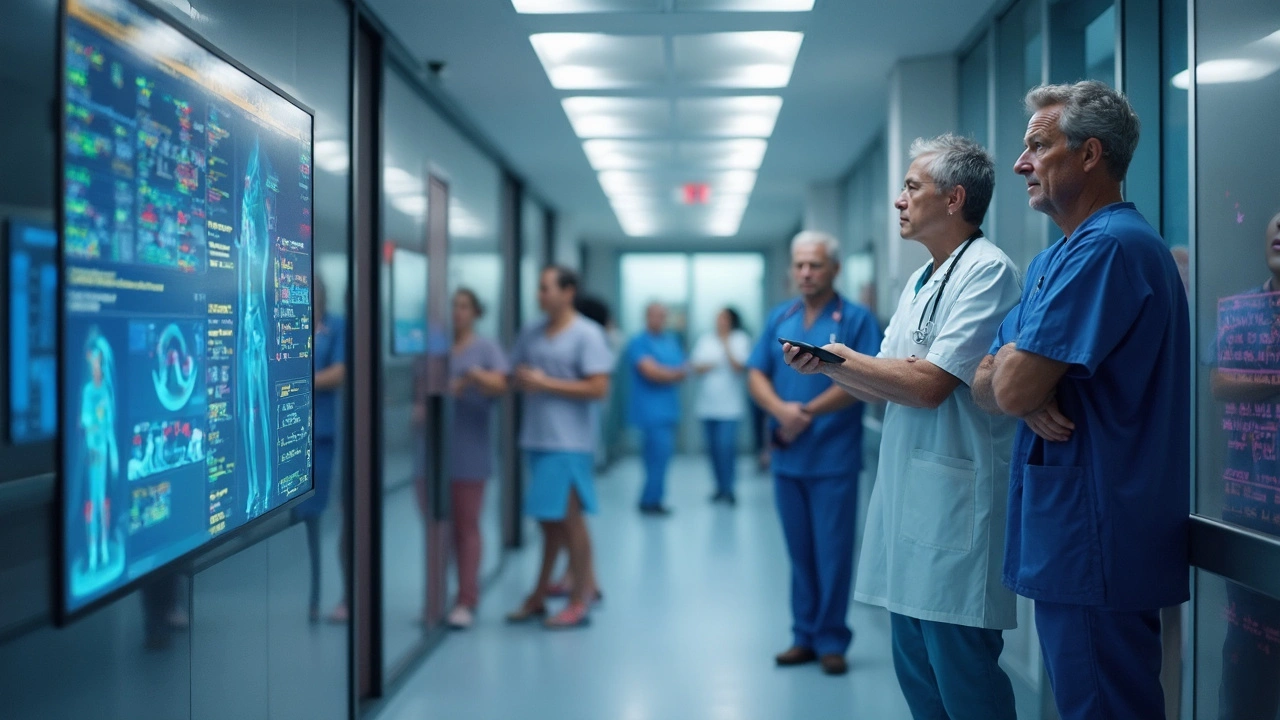If you’ve ever waited days for a test result or worried about a missed diagnosis, AI in healthcare is about to make your life a lot easier. Today’s AI tools can scan X-rays, read bloodwork, and catch signs a human might miss—all in minutes, not days. No, it’s not science fiction; it’s happening now in clinics and even on smartphones.
Say you walk into a clinic with a weird rash. The nurse snaps a photo, and in seconds, an AI compares it to millions of other images, giving doctors a quick shortlist of possible causes. For a patient, that means less guesswork and fewer referrals bouncing from one specialist to another. It’s not just skin conditions, either—AI is spotting lung cancer on CT scans, warning about heart trouble from EKGs, and even flagging diabetic eye disease before symptoms show up.
For anyone dealing with nagging health issues or worried about family history, these systems can mean faster answers and a better chance of catching problems early. Of course, AI isn’t making the final call—doctors use its input to back up their judgment. But it’s basically like having an extra expert in the room every time you see a doctor.
- How AI Diagnoses Work
- Real-World Success Stories
- What Doctors and Patients Think
- Tips for Using AI in Your Healthcare
How AI Diagnoses Work
When you hear that ai diagnosis tools help doctors, it’s not about robots replacing humans—it’s about smart software giving docs more reliable info. These systems use something called machine learning, which means they study millions of examples (like X-rays, lab results, or even health records) to figure out what’s normal and what’s not. It’s basically digital pattern recognition on steroids.
Picture this: A specialist wants to check if a weird mole on your arm could be skin cancer. The AI system looks at your photo and compares it to thousands of images already labeled by experts. It checks for size, color, edges, and patterns. Within seconds, it ranks the risk and lets the doctor know if you should see a dermatologist ASAP or just keep an eye on it.
Behind the scenes, most medical ai systems are trained on huge datasets. For example, AI reading chest X-rays at some hospitals has been trained on over 200,000 images. These databases aren’t just big—they’re also high quality, with every image double-checked by real doctors. This training helps the software spot tiny details, like a faint shadow that might signal early pneumonia or lung cancer.
| Test Type | AI Accuracy | Typical Doctor Accuracy |
|---|---|---|
| Mammogram (Breast Cancer) | 94% | 88% |
| Skin Lesion Images | 91% | 86% |
| Lung CT Scans | 96% | 93% |
AI can also pull together info that was scattered in the past. Say you’ve got odd symptoms. The software can check everything—lab results, medical history, even your wearable device data—to give your doctor a broader view. This teamwork speeds up diagnosis and helps avoid human slipups.
When it comes down to it, future healthcare will see AI pinched into more areas: from quick triage in ERs to figuring out the rare stuff that leaves regular doctors scratching their heads. The key? It’s always a combo—AI does the scanning, but the human expert makes the final call. That means you get the best of both worlds: high-tech accuracy and human experience.
Real-World Success Stories
You don’t have to dig deep to see ai diagnosis in action. One of the most talked-about successes is Google Health’s AI for spotting breast cancer on mammograms. In a 2020 study, this system missed fewer cases than human radiologists and also made fewer false alarms. Even experienced doctors welcomed the backup, since the AI could highlight tiny details that sometimes went unnoticed.
The same story plays out with medical ai used in eye clinics. Hospitals in the UK started using a tool by DeepMind (owned by Google) for diagnosing eye problems from scans. It reaches the right answer as well as specialists, and it can process scans faster. That means patients get treated before the problem gets worse.
Some breakthroughs are closer to home, too. Smartphone apps powered by ai diagnosis are helping people track skin changes, spot potential moles, and even detect skin cancer risks early. For parents worrying about rashes or odd spots on their kids, that’s peace of mind in a few minutes, not a week of stressing out.
Want some numbers? In the US, an AI system called IDx-DR got FDA clearance in 2018 to detect diabetic eye disease with no doctor present. Here’s how it stacks up against human doctors:
| AI System (IDx-DR) | Human Ophthalmologist |
|---|---|
| 87% sensitivity | 80-85% sensitivity |
| 90% specificity | 85-90% specificity |
It doesn’t replace the doctor, but it sure speeds things up, especially in small clinics with limited specialists. These real-world wins show future healthcare is not just hype—it’s happening right now, making actual visits smoother and improving outcomes for regular people.

What Doctors and Patients Think
Doctors and patients have a lot to say about ai diagnosis and how fast it’s changing healthcare. Most doctors are using these tools to help back up their decision-making, not replace it. In fact, according to a 2024 Mayo Clinic survey, about 70% of U.S. physicians say that AI helps them spot things faster, especially in radiology and cardiology.
Some doctors, though, still worry about trusting a computer’s judgment over their own. They want to make sure that if an AI flags a potential problem, it’s really accurate. Dr. Lisa Sanders, a well-known internist and medical writer, said,
“AI doesn’t get tired, and it won’t get distracted by a buzzing phone or a bad night’s sleep. But you always need a skilled doctor to make sense of what the machine finds.”
On the patient side, there’s a mix of excitement and skepticism. Patients love the idea of getting results faster or not having to wait weeks for an answer. A 2023 Pew Research study found that 60% of people would trust AI-generated results if their doctor explained how it works and was involved in their care. The main worry? Some folks fear that too much tech could make medicine less personal.
- Medical ai is more likely to be trusted if a real doctor reviews and explains the results.
- Patients dealing with chronic illnesses report feeling more confident when AI checks are part of their routine—especially for things like diabetes and heart health.
- The best results happen when AI and humans work together, not when AI runs the show alone.
Here’s a quick look at how doctors and patients rate AI in diagnosis:
| Doctors (% positive) | Patients (% positive) | |
|---|---|---|
| Faster results | 75 | 80 |
| Trusted accuracy | 68 | 65 |
| Tech anxiety | 25 | 35 |
This feedback shapes how future healthcare will use AI—combining speed and accuracy with the judgment only people can bring.
Tips for Using AI in Your Healthcare
Jumping into ai diagnosis tech doesn’t mean letting a robot doctor run the show. It just means being smart with new tools. Want to use these advances without getting lost in the buzz? Start with the basics.
- Check Your Sources: Not all health apps are built the same. Stick to AI tools from big hospitals, government agencies, or well-known companies. For example, the Mayo Clinic, Cleveland Clinic, and NHS all back certain digital platforms with real science.
- Share Results With Your Doctor: Don’t treat any AI diagnosis as gospel. Bring the results to your regular doctor—real pros want patients using reliable healthcare technology, but they also need context and a full medical history.
- Keep Data Safe: AI tools ask for your personal info to work well. Make sure the app or platform uses encryption and is up front about privacy. Look for the padlock symbol and review privacy policies before signing up.
- Know the Limits: Medical ai is getting smarter, but it’s not perfect. Use these tools as a second set of eyes, not a replacement for in-person care—especially for urgent symptoms or anything that feels serious.
- Track Changes Over Time: Some AI tools let you record symptoms or test results and see patterns. This is a bonus if you deal with ongoing issues like blood sugar, heart rate, or skin changes. Bring these trends to appointments—it helps your doc spot what’s up faster.
Here’s a quick look at how people are using AI in real life:
| AI Tool | Main Use | Who Uses It Most |
|---|---|---|
| Google Health AI | Eye disease from diabetes | Ophthalmologists |
| SkinVision | Checking skin moles | Everyday users |
| AliveCor Kardia | EKG analysis | Patients with heart issues |
| IBM Watson Health | Cancer diagnosis support | Doctors in hospitals |
One last thing: AI can save time and spot stuff humans might miss, but no algorithm replaces a doctor’s instincts or experience. Use future healthcare tools as a safety net, not as an excuse to skip out on real medical advice. When in doubt, always check in with a pro who knows your full story.

